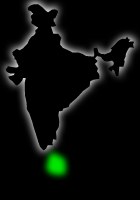|
 Sri Lanka and India have been associated culturally, mythologically and historically together for centuries. To a majority of the Hindu population in India, the mythology of Ramayana is woven around both the countries. Like India, Sri Lanka is also a home to followers of various religious faiths. Buddhism is followed by a majority of the population. Hinduism, Islam and Christianity are observed by a small section of the Sinhalese. Buddhism was introduced in Sri Lanka by the son of the great Indian Emperor Ashoka, Arahat Mahinda, on one of his missionary journeys. Sri Lanka and India have been associated culturally, mythologically and historically together for centuries. To a majority of the Hindu population in India, the mythology of Ramayana is woven around both the countries. Like India, Sri Lanka is also a home to followers of various religious faiths. Buddhism is followed by a majority of the population. Hinduism, Islam and Christianity are observed by a small section of the Sinhalese. Buddhism was introduced in Sri Lanka by the son of the great Indian Emperor Ashoka, Arahat Mahinda, on one of his missionary journeys.
 The Sinhalese New Year Aluth Avuruddha, the Indian Tamil New Year Varsha Pirappu and the New Year of the Malyalees, Vishu, are celebrated around the same time in the month of April. The festivities are marked with a lot of traditional and culinary varieties in which women play a significant role. Much of the Sinhalese diet is similar to South India which involves a lot of coconut based dishes. Rice forms the staple food of the Sinhalese. The similarity in weather between Sri Lanka and South India have given rise to a number of coffee, rubber and spices plantations in both the countries. The Sinhalese New Year Aluth Avuruddha, the Indian Tamil New Year Varsha Pirappu and the New Year of the Malyalees, Vishu, are celebrated around the same time in the month of April. The festivities are marked with a lot of traditional and culinary varieties in which women play a significant role. Much of the Sinhalese diet is similar to South India which involves a lot of coconut based dishes. Rice forms the staple food of the Sinhalese. The similarity in weather between Sri Lanka and South India have given rise to a number of coffee, rubber and spices plantations in both the countries.
Sinhalese, Tamil and English are the languages spoken by the people of Sri Lanka. Sarees form the traditional attire of the Sinhalese women. However, the style of wearing the saree is different. A lot of cultural and educational exchanges take place between Indians and Sinhalese. India is a popular destination for Sri Lankan students to pursue higher education. Cricket is a game played by both countries. India majorly exports cement and chemicals to Sri Lanka. Coconut and cardamom are principally imported by India from Sri Lanka.
|





